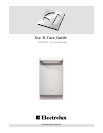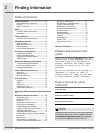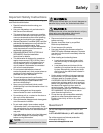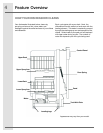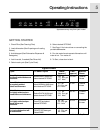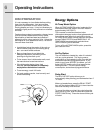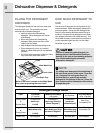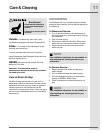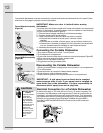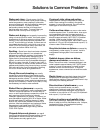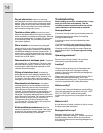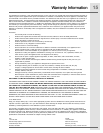
14
Do not place silver next to or touching
stainless steel utensils in dishwasher silverware
basket. This can cause pitting of stainless steel
blades. (Most silver knives have stainless steel
blades. Do not let blades touch other stainless
steel utensils during wash cycle.)
Tarnish on silver plate occurs when worn
down to the base metal and turns a bronze color
when exposed to hot water and detergent. Remove
bronzing by soaking item in vinegar for 10 minutes
or use a silver polish. For permanent protection,
have silver replated.
Silver tarnish can be caused by prolonged
contact with air or with foods containing sulphur
like eggs, mayonnaise, or seafood. Contact with
undissolved detergent can also cause tarnish. To
prevent this, rinse silver soon after use. Use care
not to pour detergent directly onto silver. Remove
tarnish with a silver polish.
Discoloration of stainless steel—Food soil
can create a film or discoloration. To avoid, rinse
stainless items promptly. Food soil films can be
removed with a stainless steel cleanser or mild
cleanser. Rinse thoroughly.
Pitting of stainless steel is caused by
prolonged contact with detergent granules and
foods like salt, mayonnaise, fruits, butter or milk.
To prevent, rinse soon after use. Do not allow
detergent to fall directly onto stainless steel items.
Discoloration of aluminum—Anodized
(colored) aluminum cannot withstand machine
washing. Resulting loss of color is permanent.
Other aluminum may darken when machine
washed. To decrease chance of discoloration, do
not place aluminum directly beneath detergent
dispenser. To brighten darkened items, scour with
soap filled steel wool pads. For severely darkened
pans, simmer an acidic food or a solution of
2 teaspoons (10 ml) cream of tartar per quart
(1 L) of water for 1/2 hour. Scour with soap filled
steel wool pad, rinse and dry.
Knife handles become loose when the
cement is exposed to very hot water. Test wash a
single knife for several weeks. Damaged knives
should be professionally re-cemented.
Noise problems?
It is normal to hear swishing and pulsating sounds.
These sounds mean that water is circulating
through the dishwasher.
It is normal to hear motor sounds before water
enters tub.
Loud ticking usually means something is hitting
wash arm. See Preparing and Loading Dishes.
Vibrating or rattling sounds can mean dishes are
touching each other. See Preparing and Loading
Dishes.
Operating problems?
Be sure door is firmly closed. It is normal for
dishwasher to pause between cycles.
Leaking?
Check for items sticking out of dishwasher that
could prevent door from closing and sealing
properly. Use only fresh dishwashing detergent to
avoid oversudsing.
Water coming through door vents? When a dish is
added after starting dishwasher, wait a few
seconds before latching door. This permits entering
cold air to expand slowly inside dishwasher.
Dishes not dry?
Check to see if rinse aid dispenser needs refilling.
Hot water temperature may be too low (min. 120°F
49°C). If COOL DRY option is being used,
additional drying time may be required with door
open.
Before calling for service, review this list. It may
save you both time and expense. This list
includes common experiences that are not the
result of defective workmanship or material.
Troubleshooting
Water in tub?
A small amount of water in bottom of tub is normal.
It keeps water seal lubricated.
Detergent left in cup?
Detergent may be too old. Discard old
detergent.Use fresh detergent. Dishes may not be
loaded properly. Be sure items do not protrude
from front of bottom rack preventing detergent cup
from opening.



